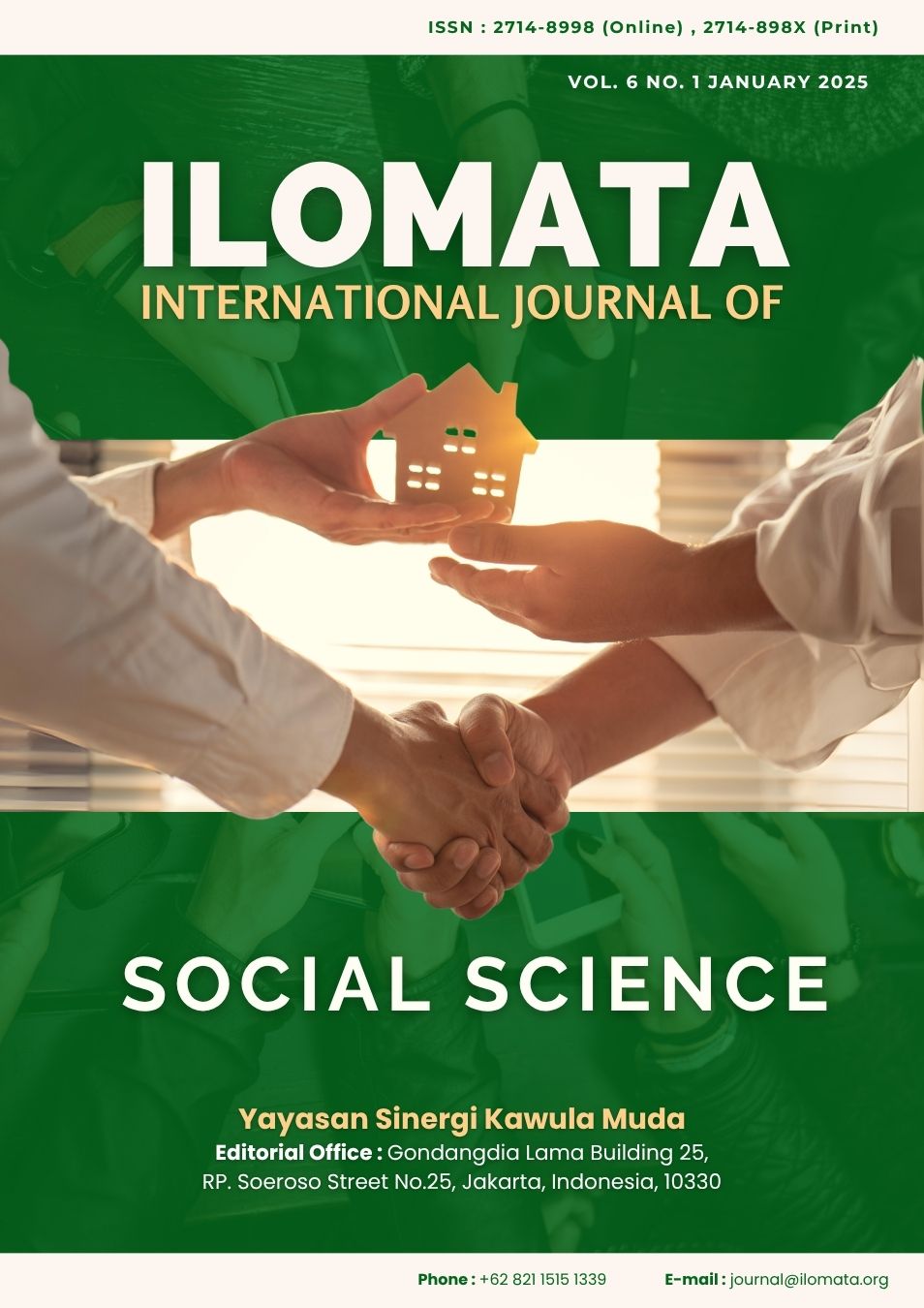Main Article Content
Abstract
Self-presentation is conveying or communicating information about an individual, how they perceive something, and how individuals can influence the feelings of others who have about themselves. Self-presentation carried out by individuals presents themselves differently from the authentic self, including the authentic self, the ideal self, and the false self in social media interaction. This study aims to test the validity of the Self-Presentation instrument on Facebook users. This instrument measures how Facebook users present themselves on the platform. A total of 324 Facebook users participated in this study. Data were collected through an online questionnaire. The analysis showed that the Self-Presentation instrument's initial measurement model did not meet the fit criteria. Therefore, modifications were made by eliminating items with low factor loadings and high residual variance. After modification, the measurement model of the Self-Presentation instrument showed a good fit with a GFI value of 0.993, RMSEA of 0.088, CFI of 0.973, and TLI 0.949.
Keywords
Article Details

This work is licensed under a Creative Commons Attribution 4.0 International License.
References
- Ahmed, S. (2014). Strategi Self-Presentation pada Remaja Pengguna Media Sosial Instagram. Jurnal Psikologi Sosial, 12(1), 45-56.
- Azwar, S. (2016). Reliabilitas dan validitas dalam penelitian psikologi. Pustaka Pelajar.
- Boateng, G. O., Neilands, T. B., Frongillo, E. A., Melgar-Quiñonez, H. R., & Young, S. L. (2018). Best practices for developing and validating health, social, and behavioral research scales: A primer. Frontiers in Public Health, 6, 149. https://doi.org/10.3389/fpubh.2018.00149
- Dumas, T. M., Maxwell-Smith, M., Davis, J. P., & Giulietti, P. A. (2017). Lying or longing for likes? Narcissism, peer belonging, loneliness and normative versus deceptive like-seeking on Instagram in emerging adulthood. Computers in human behavior, 71, 1-10. DOI: 10.1016/j.chb.2017.01.037
- DeVellis, R. F. (2017). Scale development: Theory and applications (4th ed.). Sage Publications.
- Etikan, I., Musa, S. A., & Alkassim, R. S. (2016). Comparison of convenience sampling and purposive sampling. American Journal of Theoretical and Applied Statistics, 5(1), 1-4. https://doi.org/10.11648/j.ajtas.20160501.11
- Ferryanti, D., Setiasih, L. S., & Kesumaningsari, D. (2020). Self-Presentation berperan terhadap Psychological Well-Being. Jurnal Ilmiah Psikologi Mind Set, 11(2), 89-98. https://journal.univpancasila.ac.id/index.php/mindset/article/download/1940/1543/
- Flesch, R. (1948). A new readability yardstick. Journal of Applied Psychology, 32(3), 221–233. https://doi.org/10.1037/h0057532
- Fornell, C., & Larcker, D. F. (1981). Evaluating structural equation models with unobservable variables and measurement error. Journal of Marketing Research, 18(1), 39-50. https://doi.org/10.2307/3151312
- Ghozali, I. (2021). Aplikasi analisis multivariate dengan program IBM SPSS 26. Badan Penerbit Universitas Diponegoro.
- Gil-Or, O., Levi-Belz, Y., & Turel, O. (2015). The “selfie” generation: Examining the relationship between social media self-presentation and personality. Personality and Individual Differences, 87, 206–211. https://doi.org/10.1016/j.paid.2015.07.039
- Goffman, E. (1959). The Presentation of Self in Everyday Life, New York: Achor Books.
- Hair, J. F., Black, W. C., Balin, B. J., Anderson, R. E. (2010). Multivariate data analysis. New York: Maxwell Macmillan International Editions.
- Haryono, S., & Wardani, R. (2020). Pengaruh validitas konstruk dalam pengukuran perilaku online self-presentation. Jurnal Psikologi Sosial, 18(2), 134-145.
- Hootsuite (We are Social): Indonesian Digital Report 2022 | Dosen, Praktisi, Konsultan, Pembicara/Fasilitator Digital Marketing, Internet marketing, SEO, Technopreneur dan Bisnis Digital. (n.d.). Retrieved November 4, 2024, from https://andi.link/hootsuite-weare-social-indonesian-digital-report-2022/
- Hu, Y., Manikonda, L., & Kambhampati, S. (2014, May). What we Instagram: A first analysis of Instagram photo content and user types. In Proceedings of the International AAAI Conference on Web and Social Media (Vol. 8, No. 1, pp. 595-598). https://doi.org/10.1609/icwsm.v8i1.14578
- Hu, L., & Bentler, P. M. (1999). Cutoff criteria for fit indexes in covariance structure analysis: Conventional criteria versus new alternatives. Structural Equation Modeling: A Multidisciplinary Journal, 6(1), 1-55. https://doi.org/10.1080/10705519909540118
- Kline, R. B. (2015). Principles and practice of structural equation modeling (4th ed.). Guilford Publications.
- Michikyan, M., Dennis, J., & Subrahmanyam, K. (2015). Can You Guess Who I Am? Real, Ideal, and False SelfPresentation on Facebook Among Emerging Adults. Emerging Adulthood, 3(1), 55–64. https://doi.org/10.1177/2167696814532442
- Moningka, S., & Selviana, D. (2021). Adaptasi dan validasi skala self-presentation pada mahasiswa pengguna media sosial di Jabodetabek. Jurnal Psikologi Sosial, 19(2), 134-145.
- Novianti, R., & Rahmat, H. (2022). Self-presentation di media sosial dan dampaknya terhadap kesejahteraan psikologis. Jurnal Ilmu Psikologi, 14(1), 89-102.
- Rahmawati, L., & Warastri, A. (2022). Hubungan Intensi Penggunaan Aplikasi TikTok dengan Perilaku Narsisme Mahasiswa di Yogyakarta. Jurnal Psikologi Universitas Muhammadiyah Lampung, 10(1), 15-25.
- Rahmah, T. R., Permatasari, N., & Rustham, A. T. P. (2019). Hubungan Antara Self-Presentation pada Media Sosial dan Pembentukan Identitas Diri pada Remaja Akhir. Prosiding Temu Ilmiah Nasional (TEMILNAS XII), 134-143. https://ojs.unm.ac.id/Temilnas/article/download/20026/11535
- Ramadhani, F., & Ningsih, Y. T. (2021). Kontribusi Self-Esteem terhadap Self-Presentation pada Remaja Pengguna Instagram. Jurnal Pendidikan Tambusai, 5(2), 2986-2991. https://jptam.org/index.php/jptam/article/download/1330/1172/
- Sa’diyah, S. A., & Fauziyah, N. (2021). Pengaruh Harga Diri dan Kesadaran Diri Terhadap Presentasi Diri Pada Remaja Pengguna Media Sosial. 13. https://doi.org/10.36269/psyche.v5i1.1217
- Salim, F., Rahardjo, W., Tanaya, T., & Qurani, R. (2017). Are self-presentations of Instagram users influenced by friendship-contingent self-esteem and fear of missing out? Makara Hubs Asia, 21(2), 70-82. DOI: 10.7454/mssh.v21i2.689
- Tama, B. A. (2019). Validitas Skala Presentasi Diri Online. JP3I (Jurnal Pengukuran Psikologi dan Pendidikan Indonesia), 7(1), 1-7. DOI: 10.15408/jp3i.v7i1.12102
- Vogel, E. A., & Rose, J. P. (2016). Self-reflection and interpersonal connection: Making the most of self-presentation on social media. Translational Issues in Psychological Science, 2(3), 294–302. https://doi.org/10.1037/tps0000076.
- Wright, K. B. (2005). Researching Internet-based populations: Advantages and disadvantages of online survey research, online questionnaire authoring software packages, and Web survey services. Journal of Computer-Mediated Communication, 10(3), JCMC1034. https://doi.org/10.1111/j.1083-6101.2005.tb00259.x
- Yang, C. C., & Brown, B. B. (2016). Online self-presentation on Facebook and self-development during the college transition. Journal of Youth and Adolescence, 45(2), 402–416. https://doi.org/10.1007/s10964-015-0385-y

